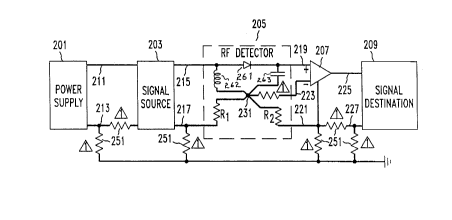Some of the information on this Web page has been provided by external sources. The Government of Canada is not responsible for the accuracy, reliability or currency of the information supplied by external sources. Users wishing to rely upon this information should consult directly with the source of the information. Content provided by external sources is not subject to official languages, privacy and accessibility requirements.
Any discrepancies in the text and image of the Claims and Abstract are due to differing posting times. Text of the Claims and Abstract are posted:
| (12) Patent: | (11) CA 2124480 |
|---|---|
| (54) English Title: | DC COUPLED AMPLIFIER FED BY AN RF DETECTOR |
| (54) French Title: | AMPLIFICATEUR A LIAISON DIRECTE ALIMENTE PAR UN DETECTEUR RF |
| Status: | Deemed expired |
| (51) International Patent Classification (IPC): |
|
|---|---|
| (72) Inventors : |
|
| (73) Owners : |
|
| (71) Applicants : | |
| (74) Agent: | KIRBY EADES GALE BAKER |
| (74) Associate agent: | |
| (45) Issued: | 1998-09-15 |
| (22) Filed Date: | 1994-05-27 |
| (41) Open to Public Inspection: | 1995-02-10 |
| Examination requested: | 1994-05-27 |
| Availability of licence: | N/A |
| (25) Language of filing: | English |
| Patent Cooperation Treaty (PCT): | No |
|---|
| (30) Application Priority Data: | ||||||
|---|---|---|---|---|---|---|
|
A DC coupled amplifier fed by an RF detector is disclosed which has
greater dynamic range capabilities than techniques in the prior art. An illustrative
embodiment of the present invention advantageously comprises a low-offset voltage,
low-offset current differential amplifier fed by an RF detector having a fifth lead
from the reference voltage node within the RF detector.
Amplificateur à couplage c.c. alimenté par un détecteur RF offrant une gamme dynamique plus étendue que celles qu'offrent les techniques existantes. Dans une application de la présente invention, un amplificateur différentiel à faible décalage et à faible courant est alimenté par un détecteur RF doté d'un cinquième conducteur relié au noeud de tension de référence du détecteur RF.
Note: Claims are shown in the official language in which they were submitted.
Note: Descriptions are shown in the official language in which they were submitted.

For a clearer understanding of the status of the application/patent presented on this page, the site Disclaimer , as well as the definitions for Patent , Administrative Status , Maintenance Fee and Payment History should be consulted.
| Title | Date |
|---|---|
| Forecasted Issue Date | 1998-09-15 |
| (22) Filed | 1994-05-27 |
| Examination Requested | 1994-05-27 |
| (41) Open to Public Inspection | 1995-02-10 |
| (45) Issued | 1998-09-15 |
| Deemed Expired | 2003-05-27 |
There is no abandonment history.
| Fee Type | Anniversary Year | Due Date | Amount Paid | Paid Date |
|---|---|---|---|---|
| Application Fee | $0.00 | 1994-05-27 | ||
| Registration of a document - section 124 | $0.00 | 1994-11-18 | ||
| Maintenance Fee - Application - New Act | 2 | 1996-05-27 | $100.00 | 1996-04-04 |
| Maintenance Fee - Application - New Act | 3 | 1997-05-27 | $100.00 | 1997-04-07 |
| Maintenance Fee - Application - New Act | 4 | 1998-05-27 | $100.00 | 1998-03-25 |
| Final Fee | $300.00 | 1998-05-11 | ||
| Maintenance Fee - Patent - New Act | 5 | 1999-05-27 | $150.00 | 1999-03-19 |
| Maintenance Fee - Patent - New Act | 6 | 2000-05-29 | $150.00 | 2000-03-20 |
| Maintenance Fee - Patent - New Act | 7 | 2001-05-28 | $150.00 | 2001-03-19 |
Note: Records showing the ownership history in alphabetical order.
| Current Owners on Record |
|---|
| AMERICAN TELEPHONE AND TELEGRAPH COMPANY |
| Past Owners on Record |
|---|
| ARNTZ, BERNARD JAMES |